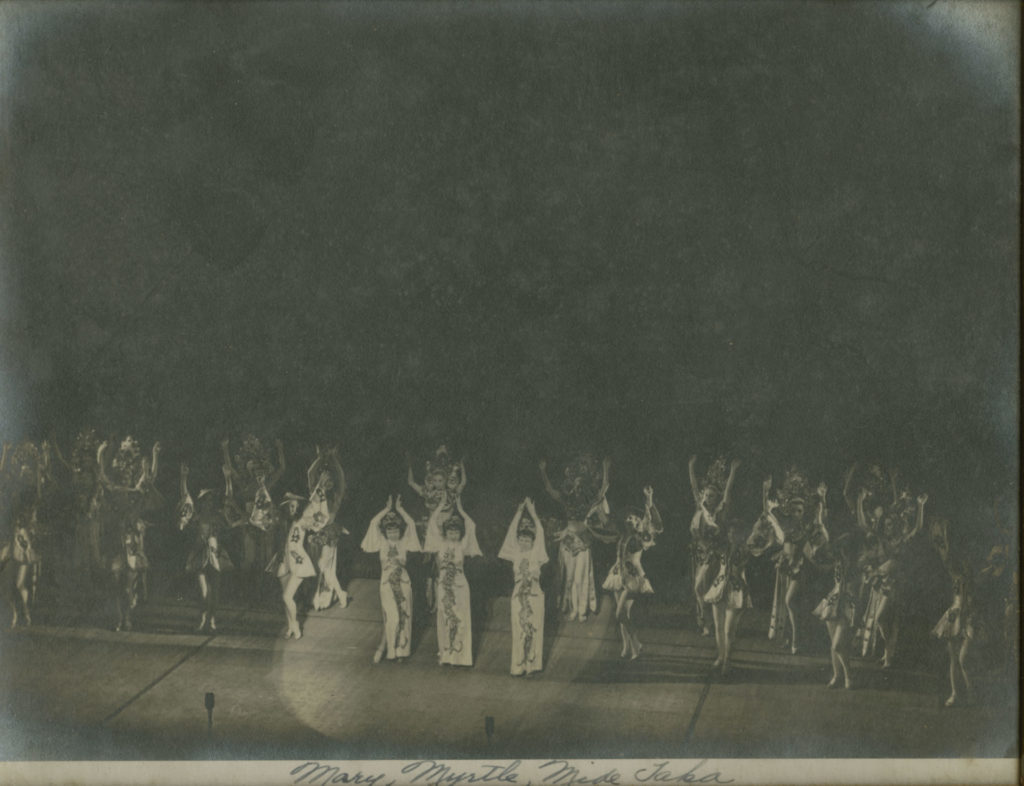
Purchase Tickets
Dancing the Blues with Hoagy Carmichael
December 21, 2022

A few years ago, I walked into the Indiana Historical Society (IHS) carrying a box of family photos. Among my photos was one of Hoagy Carmichael (1899-1981) with my late mother-in-law, Myrtle Goldfinger (1917-2011). At the time, I knew nothing about the photo beyond what I had heard from family members: Myrtle had been a professional dancer in her youth and had once danced in a short film with Hoagy Carmichael. I had no idea where or when the picture was taken, nor did I know how to find the film. These were questions that the knowledgeable staff at the IHS easily solved. Within hours, they emailed me a link to a YouTube video of Myrtle dancing to Hoagy’s song Hong Kong Blues. Their discovery put me on an unexpected research journey into the history of this rare if not unique photo of my mother-in-law with Hoagy Carmichael.

Myrtle Goldfinger (Machiko Takaoka) is seated on the bottom left. (Johnny Goldfinger and Daniella Kostroun, Indiana Historical Society)
I discovered that the photo was taken at the RCM (Roosevelt, Coslow and Mills) studio in Hollywood, CA in 1942 while Myrtle and Hoagy were filming a soundie. Soundies were short films designed to be played in coin-operated video jukeboxes that were found in bars and restaurants across America in the 1940s. The company RCM, which was part-owned by James Roosevelt (son of then President Franklin D. Roosevelt) was most responsible for developing and popularizing the soundie technology.
Myrtle’s birth name was Machiko Takaoka. She was born in Tokyo, Japan in 1917 and came to the United States as an infant. Her parents were Japanese Christian missionaries who moved to Hollywood, California in 1918 to missionize among Japanese migrant workers. Myrtle’s father died in 1930, just when the U.S. was entering the Great Depression. Myrtle and her sisters Mary and Midi, all of them talented singers, musicians, and dancers, turned to show business to support themselves in these difficult times.

Takaoka Family Portrait, 1925. (Johnny Goldfinger and Daniella Kostroun, Indiana Historical Society)
Billed as the “Taka Sisters,” they got their first job touring the Midwest with a vaudeville show. They developed a variety act that involved first tricking the audience into believing they were traditional and demure Japanese dancers, and then surprising them by throwing off their kimonos and breaking out into hot jazz moves. They became best known for their “Oriental” interpretation of the “Truckin’” dance, a popular dance coming out of Harlem in 1935. Their successful run ended tragically when Midi was brutally murdered by a jealous boyfriend in 1936. Mary stopped dancing, but Myrtle went on to dance solo in New York City under the stage name Michi Taka.

Mary, Myrtle and Midi on center stage, surrounded by chorus dancers. (Johnny Goldfinger and Daniella Kostroun, Indiana Historical Society)
How Myrtle came to work on the soundie for Hong Kong Blues is unknown. The lyrics tell the story of an African American who is arrested in Hong Kong for smoking opium. After his release, he plays jazz piano to support himself and raise money for a ticket home. He tells people he is from San Francisco even though he is from Tennessee, in the hopes this will inspire people to leave him bigger tips. The music alternates between passages with pentatonic scales that are associated with Asian music with passages containing blues scales found in African American music. Myrtle was a good fit for this unique and curious song as a dancer. Just as the song contained a mixture of “Oriental” and African American musical forms, Myrtle’s success as a dancer arose from routines that combined “Oriental” aesthetics with styles coming out of the Harlem Renaissance.
As for the song’s themes about false representation and incarceration, Myrtle was a good fit there too. Myrtle had been hiding her Japanese identity due to intense anti-Japanese sentiment during WWII. Her name appears on the film’s credits as Me Chee, a respelling of her stage name designed to appear Chinese in origin. Also, in a bizarre twist of fate, Myrtle filmed the soundie for James Roosevelt’s company the same week that President Franklin D. Roosevelt, issued Executive Order 9066 (February 19, 1942). This order authorized the U.S. War Relocation Authority to forcibly move people of Japanese ancestry into detainment camps. More than 120,000 people were processed into camps starting in March 1942. Myrtle was incarcerated at the Mazanar War Relocation Center in the California desert from June 1, 1942, to April 30, 1943.
When I first walked into the IHS with my photo of Myrtle and Hoagie, I had no idea of the connections between their artistic interests and careers. Nor could I ever have imagined the coincidences between this photo and Executive Order 9066. This photo is now part of the IHS collection. It is there to invite future questions about music, politics, race and gender in the United States through the unique lens of Hoosiers’ experiences.
Read more about Myrtle and other Asian Experiences in the Indiana Historical Society Press newest publication, Asian American Voices in Indiana. Authored by Nicole Martinez-LeGrand and Daniel Gonzales. Forward written by Nancy Nakano Conner. Check www.indianahistory.org/shop for more information.









